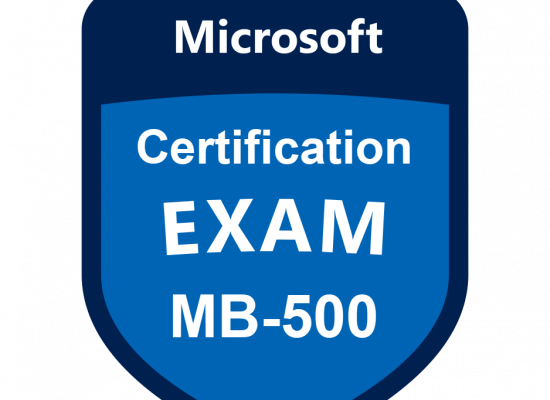AX Development Certification Exam MB6-890
Note: This exam is retired.
For current exams, please read our Microsoft Dynamics 365FO Certifications and Exams Overview (axcademy.com)
Microsoft Dynamics AX Development Certification Exam MB6-890
This preparation guide includes information and tools to assist you in preparation for the Microsoft Dynamics AX Development Certification Exam MB6-890.
Who should take this exam?
This exam is intended for individuals who plan to implement the basic technical and development tasks required to customize Microsoft Dynamics AX. This audience typically includes technical consultants, programmers, and IT personnel.
Candidates should have a basic knowledge of Microsoft Dynamics AX, Visual Studio 2015, and object-oriented programming.
Skills measured
This exam measures your ability to accomplish the technical tasks listed below. View video tutorials about the variety of question types on Microsoft exams.
Please note that the questions may test on, but will not be limited to, the topics described in the bulleted text.
Do you have feedback about the relevance of the skills measured on this exam? Please send Microsoft your comments. All feedback will be reviewed and incorporated as appropriate while still maintaining the validity and reliability of the certification process. Note that Microsoft will not respond directly to your feedback. We appreciate your input in ensuring the quality of the Microsoft Certification program.
If you have concerns about specific questions on this exam, please submit an exam challenge.
Understand the architecture and development environment (20% – 25%)
- Describe the Microsoft Dynamics AX architecture
- Identify features of Microsoft Dynamics AX; describe the development environment; describe the components in the application stack; identify cloud architecture components; explain the server architecture; describe the layer architecture
- Use Microsoft Visual Studio to manage development with Microsoft Dynamics AX
- Identify the windows and basic navigation of Visual Studio; describe differences between and uses for projects, models, solutions, and packages
Use the Application Explorer to develop new elements (25% – 30%)
- Create and manage labels and resources
- Create new label files; create and use labels; describe elements and uses for labels; identify best practices for labels; identify uses for resources
- Create and manage data types
- Describe uses for base enumerations; create new base enumerations; identify best practices for base enumerations; describe primitive and extended data types; create new extended data types; identify key properties for extended data types; implement best practices for extended data types
- Create and manage tables
- Identify the components of a table; describe various types of table relationships; describe various types of table indexes; implement best practices for tables, relationships, and indexes
Read, Write, and Understand Basic X++ (30% – 35%)
- Describe X++
- Identify the characteristics of X++; use the code editor to write X++; describe the features of IntelliSense; identify basic syntax for X++; describe the use of common key words in X++; describe the features of the debugger; use the comparison tool; use the best practice checker
- Work with X++ control statements
- Work with variables, operators, conditional statements, and loops; use built-in functions; use communication tools
- Work with classes
- Create new classes; describe scoping events and parameters; describe inheritance; identify key best practices when writing X++
- Use X++ to manipulate data
- Identify techniques for data retrieval; explain uses for transaction integrity checking; insert, update, and delete records using X++; identify best practices for manipulating data with X++
- Manage exceptions in X++
- Identify exception types; use try/catch statements; describe the features of optimistic concurrency control; describe best practices for exception handling with X++
Manage the User Interface and Security for Developers (20% – 25%)
- Manage the user interface
- Identify components of various form patterns; identify common form patterns and sub patterns; identify key properties for form elements; apply and validate form patterns; describe uses for tiles; describe how to join data in forms; implement best practices for form development
- Manage the user navigation
- Identify types of menu items; create menu items and menus; identify key properties for menu items; describe uses for menu items; implement best practices for menus and menu items
- Manage security in the development environment
- Describe the security architecture; describe the components of role-based security; create new privileges, duties, and roles in the application explorer; describe the extensible data security framework
Preparation options
Instructor led training
Self-paced training
Online learning through the Microsoft Dynamics Learning Portal (DLP) is available to Microsoft Dynamics Partners who have purchased a training pack. If you haven’t purchased a training pack, sign in to PartnerSource and view the training pack details page. Find out how to gain access to the DLP site.
This DLP course covers content for Exam MB6-890: 80730AE: Development Basics in Microsoft Dynamics AX
This course provides students with the necessary tools and resources to implement the basic technical and development tasks required to customize Microsoft Dynamics AX.
Customers on a service plan can access online learning from CustomerSource. Use the Get Trained with eLearning tile, and search for the course number 80730. Please contact mlxsupp@microsoft.com if you have questions.
More information about exams
View the complete list of Dynamics 365 FOE and AX Certification Exams


